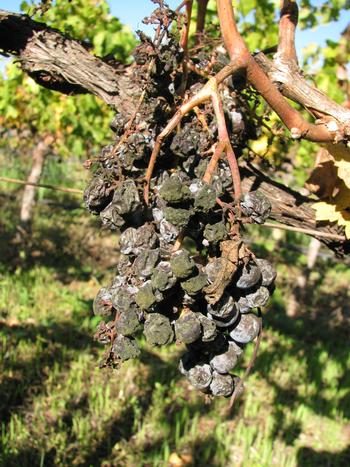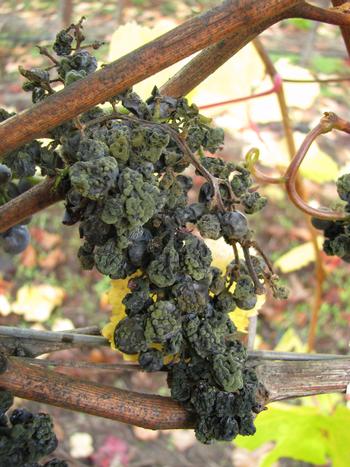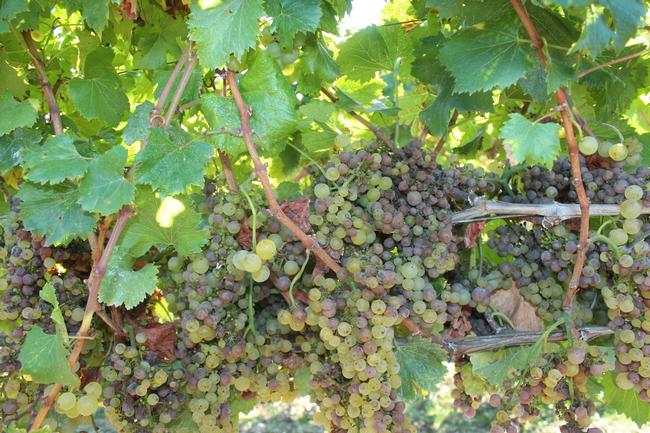Should You Drop Unsold Fruit or Leave it on the Vine?
This article originally appeared as the October 2019 Newsletter on the UCCE Sonoma County website. The first two paragraphs have been updated for 2020.
Once again, many growers are facing the dilemma of what to do with fruit that cannot be sold. For a few years prior to 2019, wine inventories had been slowly building and there was a significant inventory of bulk wine. The final straw was the record breaking 2018 harvest. In 2019, there were unsold grapes primarily because grape supply exceeded demand.
In 2020, it got complicated. The coronavirus pandemic has affected wine sales and the bulk wine market resulting in few buyers interested in purchasing uncommitted North Coast grapes. The wildfires that began in August have increased the possibility that smoke damaged fruit will be rejected by the winery. It is possible that more growers this year will have unwanted fruit and the intent of this article is to help you make an informed decision regarding that fruit.
See also: Crop loss reporting and federal assistance.
Allowing unsold fruit to remain on the vines may seem unthinkable yet with no income from those blocks, it makes sense. This means not dropping clusters by hand and not running a harvester in the vineyard to get the berries off.
From the perspective of a plant pathologist, clusters that decompose over the winter - either on the vine or on the ground - are not likely to have a noticeable effect on fungal disease pressure the following year given common vineyard floor management practices.

All common grapevine fungal pathogens exist inside vineyards. For example, fallen petioles, rachises that remain on the vine after mechanical harvest, pruning debris and woody tendrils that cling to trellis wires all support the growth of fungi. These fungi act as sources of inoculum that can infect wounds caused by pruning and suckering, and infect berries at bloom and other green tissue.
The fungi that colonize decaying berries include the same fungi seen growing on damaged berries before harvest including Botrytis cinerea and Cladosporium and Aspergillus species which are associated with Botrytis bunch rot, Cladosporium rot and sour rot respectively. Fungi can infect then colonize the ripening berries when spores enter through the slightest opening in the berry cuticle caused by sunburn or the presence of diffuse, unseen powdery mildew. Berries are overwintering structures for these fungi and others.
Botrytis cinerea spores are ubiquitous given the fungus can survive on dead tissue as well as infect living tissue. It grows on dead calyptras (flower caps) and stamens after bloom and will infect a young berry through the wounds left when the cap is shed. In various studies, Botrytis sporulation in laboratories occurred on petioles and rachises collected from the ground and remnants of rachises collected from canes after pruning.
Inoculum produced one year may or may not carry over to the second year. The outcome depends on several factors including the fungi present in the vineyard and neighboring blocks; the weather which affects both spore release and vine phenology such as the timing of bud break and bloom; and vineyard access to conduct floor management practices.

- Prior to bud break, spores of obligate parasites released from fungal fruiting bodies and overwintering structures have no impact because there is nothing to infect.
- Eliminating pruning debris will remove the inoculum formed on decomposing clusters and pieces of canes prior to bud break. Vineyard access to alternate rows is required to incorporate last year’s wood and cluster remnants while maintaining resident vegetation or a sown cover crop in the non-tilled rows.
All common grapevine fungal pathogens exist inside vineyards and the relative importance of allowing unsold fruit to remain on the vines should be put into perspective of other vine tissues that are also decomposing.
Clusters that remain in the vineyard are not likely to have a noticeable effect on disease the following year if common vineyard floor management practices are followed.
Acknowledgement: Valuable input provided by Dr. Akif Eskalen, Cooperative Extension Plant Pathologist, UC Davis.


